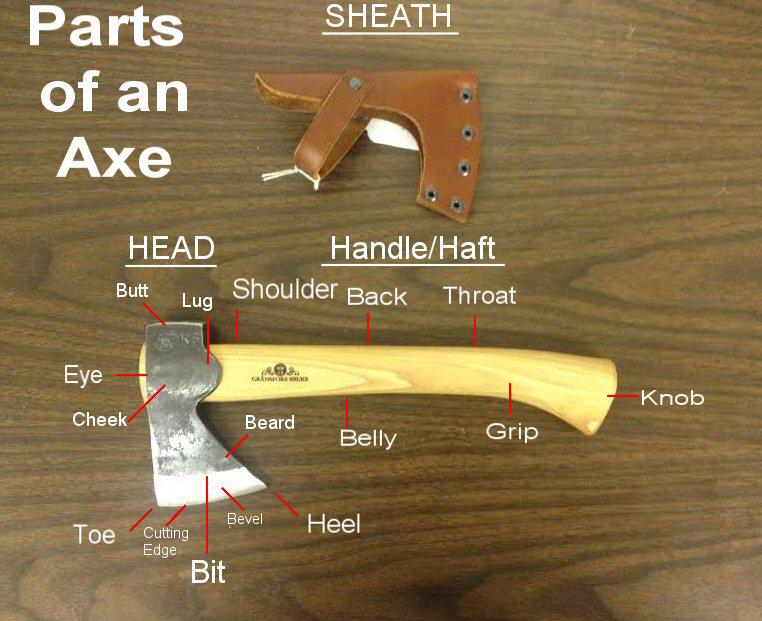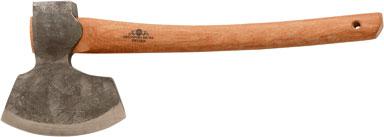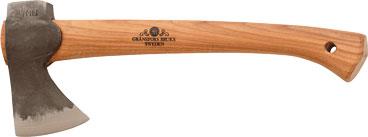by Bart Beck.
The axe is one of the simplest, yet most essential types of tools. At its simplest form, it’s a wedge set atop a lever or handle, so it can be swung with force to push apart wood or other materials. Despite its simplicity, it has helped build nations and sometimes conquer others. It created economic booms and millionaires. In fact, Williamsport, a town near us here in central Pennsylvania, is said to have had the highest concentration of millionaires in the world at one point, all thanks to Pennsylvania’s early logging industry. Despite its deep and rich history, most people have lost touch with this amazing tool, so I’d like to cover some axe basics.
Parts of an Axe
Like any other tool or instrument, gaining a deeper understanding of it requires knowing the parts. The diagram below shows an axe with its parts labeled. Some of these parts have basic, intuitive names, others, not so much.
Felling Axe
This is the tool most people would picture in their head if asked to think of an axe and is what Paul Bunyan carried over his shoulder. It has a very sharp edge, a narrow head, and medium weight. This allows the axe to cut against the grain of wood more efficiently, allowing it to cut down or “fell” standing trees. It also has a longer haft to increase the speed of the head when being swung. Many sub-types of this axe exist, most notably the American felling axe pictured above.
Felling axes often come in single or double bitted versions, each with its own advantages. The single bit axe will be of a lighter weight, which means it can be swung faster and more accurately. This often results in greater force when hitting its target, resulting in a deeper cut. The advantage of a double bitted axe comes in the fact that each bit can be maintained at a different sharpness and bevel, reducing the amount of axes that need to be taken into the woods. The type chosen often comes down to personal preference.
Splitting Maul
This type of axe has a heavy and wide head, along with a duller edge and long heft. Its primary use is for the splitting of logs along their grain. The shape of the splitting maul makes for less of a cutting tool and more of a tool used to take advantage of the wood’s weakness. By working with the grain, the wide head of the maul forces apart the wood along its layers rather than cutting it. This is why a slightly heavier weight is more important than an extremely sharp edge.
Splitting mauls will often have a large poll or butt that can double as a hammer. This aids in the ability of sinking extra wedges into a log. Wedges are useful for larger logs which cannot be split with a maul alone.
Carpenter Axe
Carpenter axes are a special axe prized for their precision. Like a felling axe, this type will have a sharp cutting edge and narrow head; however, it will be lighter for better accuracy and precision. The head of a carpenter axe will have a large beard which allows the user to choke-up and use it as a precision carving instrument. The length of the heft often depends on the overall desired use of the tool and is usually shorter and thinner.
Broad Axe
Broad axes are just that: broader than other types of axes. They have a longer cutting edge from toe to heel, sharp edge, and thin head. The main use of such an axe is to cut logs down into beams or, more simply, make the rounded sides of a log flat. These axes often come with a single bevel, which mean one side of its head is flat while the other has an angle. This allows for a flatter beam to be made but also means the tool is dedicated as a left or right handed tool.
Hatchet
The hatchet is simply an axe which is meant to be swung with one hand. Due to this broad definition, many axe heads can come in the form of a hatchet. Both the broad axe and the carpenter axe can often be considered hatchets due to their intended use and haft size. Hatchets are often popular with campers, as they can be easily packed, are light, and can be used to do anything from felling saplings to creating kindling.
What to Look For
Besides the intended use of an axe, the other important factor to consider is the materials used to make it. Quality materials can mean the difference between handing down a tool to another generation and tossing it in the garbage heap a few years down the road. Since axes are simple tools, you only need to be worried about the head and haft material.
The head of an axe should be made from some type of high quality steel. This material cannot be too hard or too soft. Some of the highest quality steel comes from the United States and Europe; however, one of the most modern and high quality steel mills in the world is now located in Brazil. Without really diving into sourcing, your best option is to stick to known, high quality brands such as Wetterlings Hatchets, Gransfors Bruks Axes, and other proven brands.
Hafts (axe handles) can be made out of anything from metal to wood. Many companies, such as Gerber and SOG are making handles from materials such as nylon. These can be durable and light, but the drawback comes in the fact that the way most of these are constructed means that if the handle is broken, its life is done. Other companies such as Fiskars are also using high quality synthetic materials for the haft that have the same positives and negatives as the nylon hafts.
My personal preference goes to good, old fashion wood or hickory to be more specific. This material is both strong and flexible, making it a great choice for a haft. If properly cared for, hickory can also last an extremely long time. If and when the haft does break, the head can be easily fitted onto a new haft. I enjoy this because, to me, axes are often more than a tool; they can hold memories, stories, and sentimental value that can be passed down through generations. The one drawback of wood is that it does require more care and maintenance than other haft materials.
I caught the axe fever long ago and I hope I never shake it. With any luck, you may contract the same affliction.








Great article. I have the axe fever myself. Love the old wc kelly perfect axes. Looking forward to purchasing a grandfors bruks small forest axe in the near future.